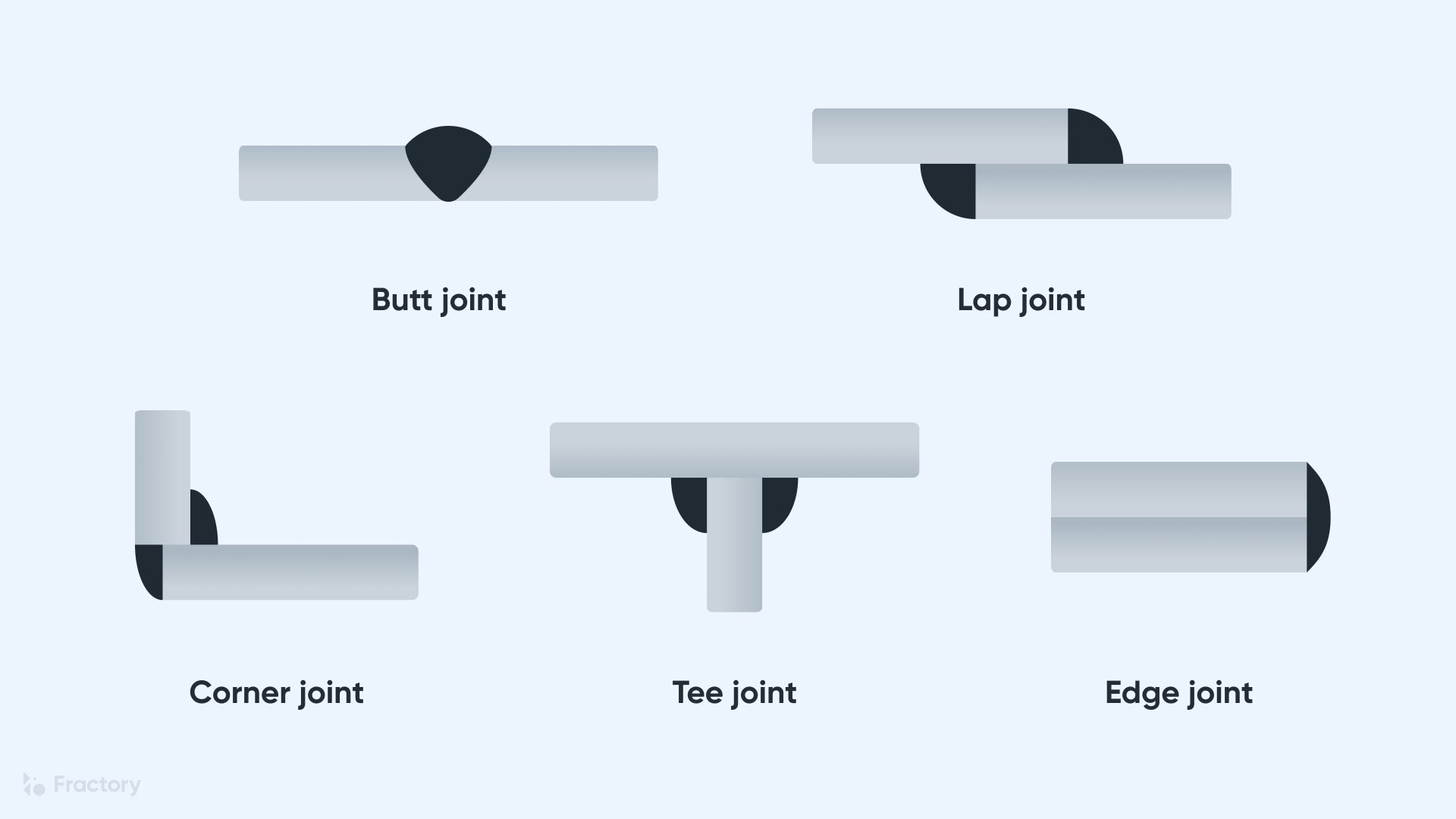Welding joints are the connections between two or more pieces of metal (or plastic) that are created during the welding process. The weld joint design complements the weld structure, the welding technique and the material. Implementing specific weld joints for a project is crucial as it is one of the main factors that will determine the strength and quality of the finished product.
Take a dive into the different types of welding joints, each with its own unique characteristics, suitable for various applications.
Welding Joint Types
Force, load, thickness, resistance and aesthetics are some of the contributing factors when it comes to determining suitable welding joints for a project. These joints may also be influenced by the type of welding process as some processes are better suited for welding in certain positions.
There are five main welding joint types used across the welding industry:
Butt Joint

Butt joints are one of the most common types of welding joints and are often used in the piping, construction, and fabrication sector. Flat pieces of metal are laid parallel with their edges touching or at a 135° to 180° angle from each other. Correctly formed butt joints where the weld metal fully penetrates the joint with complete root fusion achieve good mechanical strength, while poor welding techniques can lead to failure from incomplete penetration, burn-through, cracking or distortion.
Butt joint welding requires little to no edge preparation. Applications that require edge preparation of the edge joints would typically require specific bevel angles depending on the project’s scope. The design of a butt welding joint will greatly depend on the material thickness, backing material, edge preparation, and overall fit.
For thicker materials, a square butt joint might not be able to do the trick anymore and it becomes unavoidable to utilise some kind of groove to ensure a sound weld with proper penetration.
Butt joints can be subdivided into the following groove welds:
-
Square groove
-
Single or double bevel groove weld
-
Single or double J-groove weld
-
Single or double U-groove weld
Tee Joint

Tee joints are done by welding two perpendicular pieces of metal, forming a T-shape intersecting at approximately 90°. Tee joint is considered to be a type of fillet weld and they are also formed when welding a pipe onto a baseplate.
It is mostly used on structural steel, equipment manufacturing, and tubing since it requires little to no preparation while effectively achieving optimal mechanical strength. Fillet welds account for roughly around 70% of all joints created by various arc welding methods, such as MIG, TIG and stick welding.
Tee joints may be welded on one side where the load will be applied or at both ends to achieve maximum strength. The design of tee joints makes them susceptible to lamellar tearing since it is restricted between the two workpieces.
Tee joint design would vary depending on the material thickness, edge preparation, and work angle. Tricky work angles also exclude some types of welding methods.
Tee joints can be subdivided into these weld types:
-
Bevel groove weld
-
Fillet weld
-
Flare-bevel-groove weld
-
J-groove weld
-
Melt-through weld
-
Plug weld
-
Slot weld
Lap Joint

A lap joint is a modified butt joint more suited for materials with varying thicknesses. This is formed by overlapping the metals, forming an angle of 0-5°. Lap joints are common in the repair and sheet metal industry, wherein thin metals are used.
Welding joints using this method adds more reinforcement to the weld, given that it is properly done with no gap between the overlapping metals. Corrosion and lamellar tearing are the leading causes of failure when using this joint.
Here are the welding styles for lap joints:
-
Bevel-groove weld
-
Flare-bevel-groove weld
-
J-groove weld
-
Slot weld
-
Spot weld
- Personal account manager
- Quality assurance
- Payment terms for companies
- On-time delivery by Fractory
Corner Joint

Corner joints are similar to tee joints, with two metal bars forming a 90° fit with each other at the corner, forming an L-shape. It is popular for sheet metal welding and constructing various frames and tables.
There are two approaches when corner welding a joint, either an open or closed corner is formed. Open corner joints form a V-shape between the two metals, with the two metal edges touching each other. Closed corner joints are formed with one edge of the metal touching the face of the other metal. While a closed corner joint is more complicated than an open corner joint, it generally provides a higher overall mechanical strength.
Type of welds used for corner joints:
-
Bevel-groove weld
-
Corner-flange weld
-
Edge weld
-
Fillet weld
-
Flare-V-groove weld
-
J-groove weld
-
Square-groove weld or Butt weld
-
U-groove weld
-
V-groove weld
Edge Joint

Edge joints are similar to corner joints wherein two metals intersect at a common mating edge but have the two metals side by side. Either of the two workpieces may be bent at an angle depending on the application.
The type of edge joint will depend on how the edge of the metals is prepared. Some of these preparations include cutting, grinding, or machining into various groove types that lead to different amounts of penetration. Depending on the project requirements, edge joints may also be welded only on the edge or all around.
An edge joint may be constructed using these types of welds:
-
Bevel-groove weld
-
Corner-flange weld
-
Edge-flange weld
-
J-groove weld
-
Square-groove weld or butt weld
-
U-groove weld
-
V-groove weld
The Importance of Using the Right Type of Joint
Understanding weld joint design makes it an essential tool for determining the success of any welding project. Selecting the appropriate weld joint along with the equipment and the choice of welding method and technique is key to achieving the most robust and durable joints.
It is crucial to recognise and anticipate the forces applied to the workpiece, as it will certainly be one of the deciding factors whether the design is effective. Integrating this into the joint design will prevent structural failure down the line and helps to achieve weld integrity and quality.
Fractory offers welding services as a part of our full service – from quoting to delivery. Our network of pre-vetted manufacturing partners offers access to a wide range of processes and capabilities.



